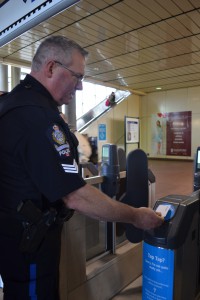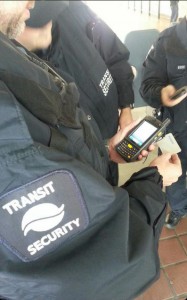Days #12-14 of Compass Beta testing
Days #12-14 of Compass Beta testing
Since I’ve been helping with small group Beta testing at stations lately, I have been getting lots of questions from both testers and curious people walking by. I figure if people are asking me the questions, some of you are probably wondering the same things.
In no particular order, here are some of the top three most frequently asked questions:

1. What happens if I forget to tap in (or out)?
The Compass system is smart, but not so smart that it can figure out where you started or ended your trip without having you tap.
That means, if you forget to tap at one end of your trip, Compass has no choice but to assume you travelled three zones and charge you accordingly. And if you actually only travelled one or two zones, that’s no fun. We don’t want that to happen.
We do have good news though: we will have lots of reminders and friendly staff around to remind you to tap in and out as you use transit. And, if the beta testers are any indication, you will just keep getting better and better at remembering to tap out the more you use the system.
2. People keep leaning on the readers on the buses, how am I supposed to tap?
The thing is, right now, about 10,000 people have Compass Beta test cards. When you consider we serve 1.2 million rides a day, that’s a pretty small percentage of our customers. And realistically, those validators do make handy posts for leaning on, so we get it.
However, fast-forward a few months to when we have hundreds of thousands of Compass Card users on the system, and it will be a different story. People will learn pretty quickly to stay out of the way of the readers, because they will be using them too.
It’ll take time, but we think people will get the hang of it. And, just in case, we have multiple validators on each bus to make it easier.

3. How will you know if someone didn’t tap in?
Just like now, Transit Police and Transit Security will still be doing fare checks to make sure people are travelling the system with valid fare. To ensure you have valid fare, you’ll need to tap in when you enter the system.
Of course, you can’t tell just by looking at a Compass Card if it’s valid or not. To do that, fare enforcement officers will carry handheld units, portable readers that scan your card and verify if it’s valid or not. It will also let officers know if additional ID is needed (such as for students using U-Pass BC).
And just like now, if anyone is caught on the system without valid fare, they’ll be subject to a $173 fine. So bottom line: don’t forget to tap in and tap out!
Beta testers: please remember you need to carry your own valid fare; the Compass Beta test card is for testing purposes only.







Just curious: why does the system charge for 3 zones when a rider forgets to tap out from a bus that only goes 1 or 2 zones? Is it because:
1. it’s hard to program;
2. Translink wants to collect info on where people get off buses;
3. Translink is hoping to overcharge;
4. people should get into the habit of tapping out so that they don’t get overcharged when they get off before their bus crosses a fare boundary;
5. something else.
I find (1) hard to believe: presumably, since the data from Compass will be used for optimization, it includes on what bus line taps were registered. (2) seems dumb, since whatever efficiency gains are made from the extra data would likely be wiped out by delays associated with people tapping to get off the bus. (3) is of course unethical. (4) doesn’t seem convincing since the number of such trips is small relative to the total number of bus trips. So I’m left to hope that there’s another reason – otherwise, this seems like a major and entirely avoidable design flaw.
I’ve used smart cards on buses in London, Boston, Montreal and Taipei (and NYC and Chicago if you count those as “smart”), and NONE of them requires tapping out of buses when exiting through the rear. Taipei even has distance-based fares for rapid transit, but it does not have it for buses presumably because having everyone tap both on and off would slow thing down too much and result in a lot of overcharging. Is there a city where people have to tap on and off on *all bus* rides, and where this is working well?
By definition, Beta testers are enthusiastic about Compass and not representative of the population. (You might try to match demographics, but the mere fact that these people applied for testing suggests they’re different in a potentially unobservable way.) Perhaps regular folks, with a monetary incentive, will become just as good at tapping out as beta testers. But it is also quite possible that regular folks take much longer, and in the meanwhile lose millions of dollars and get very angry.
I’ve noticed that on some buses, the Compass readers disconnect from the system if the bus is turned off. Does this mean that buses will now need to idle at all stops, even if it’s a timed stop where they need to sit longer? Or is there a way to keep the readers connected when the bus isn’t running?
I’ve noticed that the Compass readers on some buses disconnect when the bus is turned off. Does this mean that buses will always have to idle, even at timed stops where they are required to wait for extended periods of time? Or is there a way to keep the readers connected to the system even when the bus is off?
RE: What happens if I forget to tap in (or out)?
By that logic, if I tap in on the 99 B-Line bus at UBC, but forget to tap out at Commercial-Broadway station, I get charged for 3 zones? It’s a 1 zone trip! The bus doesn’t leave Vancouver!
This is assuming that I do not enter the faregates for the Skytrain station.
Completely ridiculous logic, TransLink.
For tapping out on the buses, could someone potentially tap out early to avoid paying for an extra zone?
Hi, Sean: By tapping out, we know how far people have gone and what the correct amount is to charge them automatically. For instance, let’s say you’re using cash credit, called Stored Value, on your card, and you intend to go two zones. At the last minute, your friend calls and you decide to get off earlier to visit him. When you tap off, you’ll just be charged for one zone instead of the two you were originally planning to travel. The other reason, is to help us better plan services for our customers. If we know which routes are really busy when, we can look into options for relieving some of that crowding and create a better experience for customers.
We know it’s going to take time for people to get into the habit of tapping in and tapping out. What we’ve heard from our testers though, is it quickly becomes a habit, just like flashing your monthly pass when you get on the bus. During the transition, we’ll have lots of materials on the system, staff on-hand and customer education to help remind people. And, if there is a mistake, you can contact our customer call centre and get it corrected.
@Steph: We’ve got our engineers on the case! They’re looking into a solution for this, thanks to feedback from beta testers like you.
@Stephanie: It’s similar to now how you could get on a bus with a one-zone pass, but travel three zones. However, if you do this, just like now, you’d be on the system without valid fare and subject to a $173 fine–not fun. Transit Police and Transit Security will continue to check fares on the system, using mobile handheld units. Plus, people will see you doing it and you’ll raise a few eyebrows. It will be much more obvious if you’re trying to evade fare than if you just had the pass in your pocket.
Unless you are riding a service that goes through 2 or 3 zones. I think riding the #16 trolley should be smart enough to know the maximum fair is one zone.
One complaint I have with those readers is the removal of “stop” buttons. I now have to lean over seated passengers or reach between legs of courtesy seat riders to let the driver know I want to get off the bus.
201+ One Word Captions For Instagram Pictures